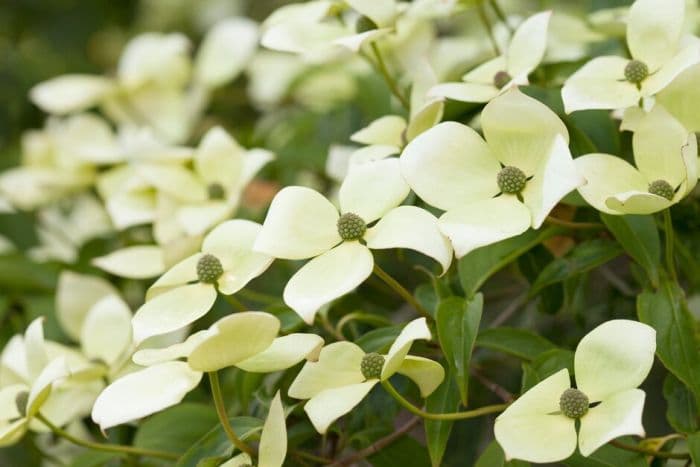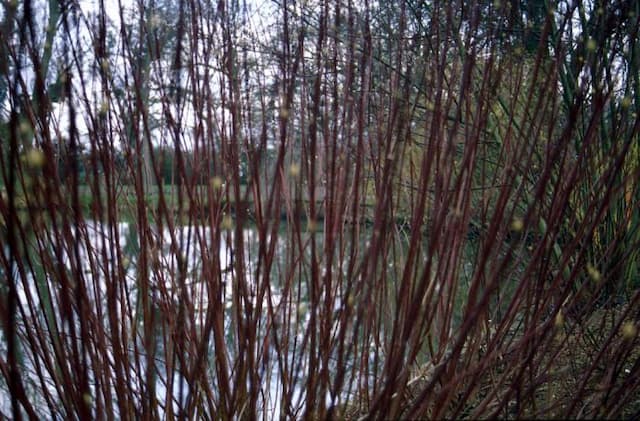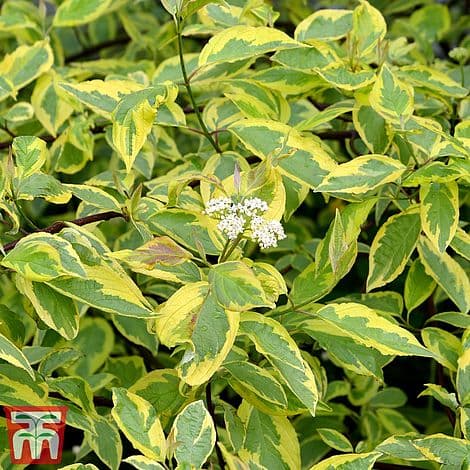Wedding Cake Tree Cornus 'Gloria Birkett'

ABOUT
The Cornus 'Gloria Birkett', commonly known as a type of dogwood, is a deciduous shrub known for its striking appearance throughout the seasons. In spring, it features a profusion of creamy white flowers, which are actually bracts surrounding the smaller, inconspicuous true flowers. As the seasons change, the foliage transforms into a fiery display of reds and purples before the leaves drop in the fall. The branches grow in a structured, yet somewhat horizontal manner, giving the plant an elegant and somewhat layered look. The bark of the young branches can have a bright, attractive hue, which adds to the winter interest of the dogwood after the leaves have fallen. Additionally, the dogwood produces berry-like fruits that are visually appealing and can attract birds and wildlife to the garden. With a robust and bushy growth habit, the plant maintains a well-furnished appearance, dense with leaves that are oval to lance-shaped, with pronounced veins giving them texture. These leaves usually have a glossy finish, adding to the plant's ornamental value. Overall, the Cornus 'Gloria Birkett' is cherished for its year-round beauty and its ability to enhance the landscape with its vibrant colors and diverse visual interest.
About this plant
 Names
NamesFamily
Cornaceae.
Synonyms
No common names available.
Common names
Cornus 'Gloria Birkett'.
 Toxicity
ToxicityTo humans
The Cornus 'Gloria Birkett' is a type of dogwood tree and is generally not considered toxic to humans. However, the fruit of some dogwood species can cause mild stomach upset if eaten in large quantities. It is always advised to avoid ingesting any plant material if its edibility is unknown or if it is not typically recognized as food.
To pets
Similarly to humans, the Cornus 'Gloria Birkett' (dogwood) is typically not toxic to pets. But, ingesting large amounts of the tree's fruit might cause mild gastrointestinal distress in pets, such as vomiting or diarrhea. It is prudent to discourage pets from consuming non-food plants to prevent any potential issues.
 Characteristics
CharacteristicsLife cycle
Perennials
Foliage type
Deciduous
Color of leaves
Green
Flower color
White
Height
20 feet (6 meters)
Spread
15 feet (4.5 meters)
Plant type
Shrub
Hardiness zones
5
Native area
Asia
Benefits
 General Benefits
General Benefits- Ornamental Appeal: Adds aesthetic beauty to gardens with attractive flowers, foliage, and form.
- Wildlife Attraction: Provides food and habitat for birds and beneficial insects.
- Low Maintenance: Generally requires minimal care once established in the landscape.
- Drought Tolerance: Capable of withstanding periods without water once mature.
- Seasonal Interest: Offers year-round interest with flowers in spring, fruits in summer, and colorful foliage in fall.
- Erosion Control: The root system can help stabilize soil on slopes and banks.
- Adaptability: Tolerates a range of soil types and conditions.
- Privacy Screen: Can be used effectively for screening and privacy due to dense growth habit.
 Medical Properties
Medical PropertiesThis plant is not used for medical purposes.
 Air-purifying Qualities
Air-purifying QualitiesThis plant is not specifically known for air purifying qualities.
 Other Uses
Other Uses- Crafting Natural Dyes: The bark and leaves of Cornus can be used to create natural dyes for coloring fabrics, yarn, or even paper products.
- Photography Backdrops: With its striking flowers and vibrant fall foliage, Cornus 'Gloria Birkett' can serve as a picturesque backdrop for both amateur and professional photography.
- Model Landscaping: Small-scale landscapes, such as model train setups or architectural models, can utilize the branches and flowers of Cornus as miniature trees or shrubs.
- Culinary Garnish: Although not edible, the flowers can be used as a decorative garnish for plating in high-end culinary dishes after ensuring they are free from pesticides.
- Insect Breeding Habitats: Some Cornus species can support the breeding of beneficial insects, such as bees and butterflies, which are important pollinators for gardens.
- Educational Tools: This plant can be used as a tool for teaching botany and horticulture, showcasing plant development and the impact of seasonal changes on flora.
- Environmental Art: Artists may use the vibrant branches and flowers in environmental art pieces that emphasize the beauty and complexity of natural forms.
- Winter Interest: The bright red stems of Cornus can be collected and used in floral arrangements to add color and interest during the winter months.
- Potpourri Ingredients: Dried flowers and leaves can be included in homemade potpourri mixes to add a natural element and subtle fragrance to the mix.
- Live Stakes for Erosion Control: The hardy stems of Cornus can be used as live stakes that take root and help stabilize soil in areas prone to erosion.
Interesting Facts
 Feng Shui
Feng ShuiThe Dogwood is not used in Feng Shui practice.
 Zodiac Sign Compitability
Zodiac Sign CompitabilityThe Dogwood is not used in astrology practice.
 Plant Symbolism
Plant Symbolism- Stability and Strength: The Cornus 'Gloria Birkett', commonly known as the Dogwood tree, often symbolizes stability and strength due to its hard and resilient wood.
- Faith and Endurance: The Dogwood is also emblematic of faith and endurance, likely because it can withstand various climates and conditions.
- Purity and Innocence: The white flowers that bloom on the Dogwood tree represent purity and innocence, making it popular in Christian symbolism, particularly around Easter.
- Resurrection and Renewal: With its association to Easter, the Dogwood's blooming is symbolic of resurrection and renewal, echoing the Christian belief in resurrection.
- Love Undiminished by Adversity: The Dogwood is a plant that can signify love that endures and remains strong even through challenges, perhaps reflected in the tree's own ability to persist through tough conditions.
 Water
WaterDogwood trees, including the 'Gloria Birkett', should be watered thoroughly once a week, providing about 1 to 1.5 inches of water which can translate to approximately 5 to 10 gallons depending on the size and age of the tree. During hot or dry periods, you may need to water twice a week, ensuring the soil is moist but not waterlogged. In the winter, reduce watering since the tree is dormant and requires less moisture. Adjust the amount and frequency based on the weather conditions and the soil's ability to retain water, aiming for consistently moist soil, especially during the first few years after planting to establish a strong root system.
 Light
LightDogwoods like 'Gloria Birkett' thrive best in conditions where they can receive partial sun to partial shade. It's ideal to plant them in a spot that is shielded from intense afternoon sun, which can be too harsh, but still gets sufficient morning light or filtered sunlight throughout the day. These conditions will help ensure vibrant foliage and optimal flowering.
 Temperature
TemperatureThe 'Gloria Birkett' Dogwood is tolerant to a range of temperatures but prefers a cooler climate. It can typically survive minimum temperatures down to about -20°F and maximum temperatures up to about 90°F. For optimal growth and health, keeping the environment between 60°F and 75°F is ideal.
 Pruning
PruningPruning the 'Gloria Birkett' Dogwood is essential to maintain its shape, remove dead or diseased wood, and encourage flower production. Prune in late winter or early spring before new growth begins, which is the best time to see the structure of the tree without leaves. Thin out the canopy to allow light and air into the interior of the tree and cut back branches that have crossed or are growing inward. Pruning should be done yearly or as needed to keep the tree healthy and aesthetically pleasing.
 Cleaning
CleaningAs needed
 Soil
SoilFor Dogwood (Cornus 'Gloria Birkett'), a well-draining soil mix rich in organic matter is ideal. Incorporate compost or peat moss into the native garden soil, aiming for a slightly acidic to neutral pH of 5.5 to 7.0.
 Repotting
RepottingDogwoods, such as Cornus 'Gloria Birkett', typically do not need frequent repotting as they are mostly grown outdoors. If container-grown, repot every 2-3 years.
 Humidity & Misting
Humidity & MistingDogwoods like Cornus 'Gloria Birkett' prefer moderate humidity but are adaptable to the ambient outdoor humidity in most growing regions.
 Suitable locations
Suitable locationsIndoor
Provide bright indirect light, moderate water, and good air circulation.
Outdoor
Plant in partial shade to full sun, enrich soil with organic compost.
Hardiness zone
5-9 USDA
 Life cycle
Life cycleThe life of a Cornus 'Gloria Birkett', commonly known as the Dogwood, begins with seed germination, where it requires a period of cold stratification to break dormancy. After germination, Dogwoods enter a juvenile vegetative stage, consisting of root and shoot development, during which they establish themselves in their environment. As they mature, Dogwoods enter the flowering stage, where they produce characteristic four-petaled inflorescences, typically in spring, which are important for reproductive success and attract various pollinators. Following pollination, Dogwoods produce fruit, often in the form of berry-like drupes, which facilitate seed dispersal by animals. In their mature phase, Dogwoods can repeatedly return to the flowering and fruiting stages annually. Eventually, environmental stresses, disease, or old age lead to the senescence and death of the plant, completing its life cycle.
 Propogation
PropogationPropogation time
Spring-Early Summer
The most popular method of propagation for the Cornus 'Gloria Birkett', commonly known as the dogwood, is through hardwood cuttings. This is typically done during the plant's dormancy in late fall to late winter. To propagate, healthy, mature stems from the current or previous year's growth are selected and cut into lengths of 6 to 9 inches (15 to 23 centimeters). The lower leaves are removed, and the cut end is dipped into rooting hormone powder to encourage root growth. The cuttings are then planted in a well-draining soil mix, with about a third of their length buried. The pots or trays holding the cuttings are kept in a cool, humid environment until roots have developed, after which the young plants can be transferred to individual pots and gradually acclimatized to outdoor conditions before planting out in their final position.









